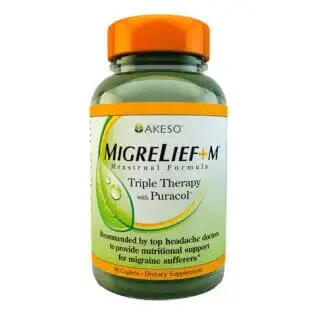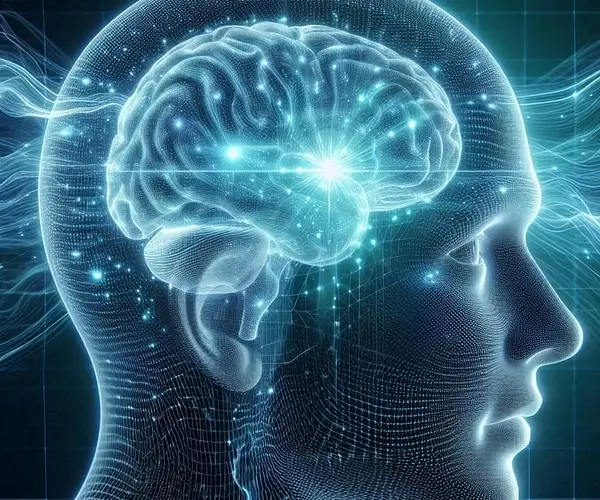Worried about your next menstrual migraine attack?
Menstrual migraines are often more severe, last longer, and are more resistant to treatment than non-menstrual migraines… So what can you do?
Consider a natural option for addressing menstrual migraines nutritionally at the cellular level, MigreLief+M. MigreLief+M is a dietary supplement formulated for chronic sufferers of menstrual and all hormonally related migraines. MigreLief has been used by hundreds of thousands of migraine sufferers and recommends by headache specialists and neurologists nationwide.
Until MigreLief+M, no one medicine was available to manage both hormonal and blood sugar fluctuations, migraines and other symptoms associated with a woman’s menstrual cycle.
+M contains the same triple therapy ingredients as MigreLief Original formula, Magnesium, Riboflavin and Feverfew which are listed in the American Academy of Neurology’s Evidence-Based Guidelines for Migraine Prevention PLUS five additional ingredients to address hormone and blood sugar fluctuations. All MigreLief daily and fast-acting formulas were formulated to address the underlying nutritional deficiencies, imbalances, and dysfunctional brain processes common to migraine sufferers.
MigreLief+M Ingredients (two caplets contain):
 High dose Riboflavin (Vitamin B-2, 400 mg/day)
High dose Riboflavin (Vitamin B-2, 400 mg/day)
Puracol Feverfew – proprietary form of whole leaf & herbal extract (100 mg/day)
Magnesium (citrate/oxide, 360mg/day)
PLUS:
Chasteberry extract (275 mg/day)
L-Theanine (100 mg/day)
D-Biotin (15 mg/day)
Pyridoxine Hydrochloride -vitamin B-6, (100 mg/day)
Chromium Picolinate (1,000 mcg/day)
It has been estimated that 70% of migraine sufferers are female. Of these female migraine sufferers, 60% to 70% report a menstrual relationship to their migraine attacks. In addition to typical premenstrual syndrome (PMS), many women also endure migraine headaches during the same few days.
Headaches in women, particularly migraines, have been related to changes in the levels of the female hormones estrogen and progesterone before, during and after a woman’s menstrual cycle. These hormone levels fluctuate dramatically and are also associated with a large percentage of migraines in women approaching menopause (Pre and Peri-menopause.)
NON-MENSTRUAL VS. MENSTRUAL-RELATED MIGRAINES
Non-menstrual migraines occur randomly and are not consistently associated with the period of time either before, during or slightly after menstruation.
Menstrual related migraines can be broken down into 3 categories:
- 1 Premenstrual migraines, which occur just prior to the commencement of menstruation
- 2 Menstrual migraines which occur during menstruation
- 3 Late menstrual migraines which occur shortly after menstruation ends
All 3 types of menstrual-related migraine attacks are often more severe, last significantly longer, and are more resistant to treatment than the usual non-menstrual migraine attacks.
Work-related disability is greater in premenstrual and menstrual migraines than in non-menstrual migraines.
The literature indicates (and is substantiated by reports from sufferers) that all menstrual-related migraine attacks were less responsive to acute prescription drug options. Only 13.5% are pain-free after 2 hours compared to 32.9% of non-menstrual migraine attacks. This indicates that 86.5% of menstrual migraine sufferers and 67.1% of non-menstrual migraine sufferers do not achieve complete relief from debilitating migraine pain after 2 hours.
DON’T WAIT TO GET YOUR MENSTRUAL MIGRAINES UNDER CONTROL
Migraines can lead to more migraines and depression.
Migraines that first occur around your menstrual cycle may become chronic over time for many reasons. “Migraines beget migraines – the more of them you have, the more vulnerable you become to having another,” according to Dr. Andrew Charles director of the Headache Research and Treatment Program in the UCLA Department of Neurology. He goes on to explain, “We’ve begun to see from researchers that the frequency of migraine attack is linked to permanent changes in the brain, and I think that changes the playing field for patients and those of us who take care” of them.
Migraines (menstrual or otherwise) are a risk factor for depression and can also lead to the vicious cycle of “Rebound Headaches” otherwise known as Medication Overuse Headaches. Continuously treating the pain and other symptoms of migraine with prescription and over-the-counter drugs can eventually increase the frequency and tendency of your migraines. This is a difficult cycle to break and often calls for detoxing and weaning off of medication.
For more information on MIGRELIEF+M and its ACTIVE INGREDIENTS visit MigreLief.com
Related Topic:
MIGRAINES & MENOPAUSE
Statistics indicate that migraines in women tend to increase during the approach to menopause and during menopause, however, they tend to decrease or go away after menopause.
Some women who have never had migraines develop them as they enter the period before and during menopause. The answer as to why this happens may be explained as follows:
A women’s monthly cycle causes significant fluctuations in estrogen during certain times of the month. This hormonal fluctuation (decreasing levels of estrogen) is known to trigger menstrual migraines in as many as 1/3-1/2 of women with migraines.
Therefore, it is not surprising, that the decreasing levels of estrogen associated with menopause, may also trigger migraines in women. The solution in both cases may be to maintain a healthy diet, exercise, and add nutritional supplements to your daily regimen known to benefit migraine sufferers and balance hormone levels.
Migraine headaches can severely affect women undergoing the changes of menopause. They can range from mild to debilitating. Migraine headaches are closely linked to a woman`s hormones; as a result they experience five times as many migraines as men. An estimated 30% of women experience migraine headaches before menopause, and that percentage only increases during the time of menopause.
If your migraines, whether menstrual or menopausal related or not, are occurring several times a month or more, and you find yourself unable to function while reaching for pain medications more and more, you are a good candidate for migraine prevention, to stop migraines from occurring in the first place.


